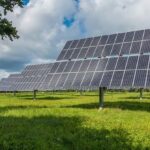Five Ways to Accelerate the Transition to Renewable Energy at This Stage
Making renewable energy technologies a global public good
If renewable energy technologies are to become a global public good, that is, accessible to all, not just the wealthy, barriers to knowledge sharing and technology transfer, including intellectual property rights barriers, must be removed.
Critical technologies, such as battery systems, allow energy to be stored from renewable sources, such as the sun and wind, and released when people, communities and businesses need power. According to the International Renewable Energy Agency, they help increase the flexibility of the energy system because of their unique ability to quickly absorb, retain and release power again.
In addition, when combined with renewable energy sources, battery technologies can provide a reliable supply of cheaper electricity in isolated grids and in communities from remote areas not connected to the general power grid.
Improved global access to components and raw materials
Reliable supplies of components and raw materials for renewable energy are critical. Greater access to all major components and raw materials, from the minerals needed to build wind turbines and power grids to electric vehicles, will be key.
A significant international coordination effort will be required to expand and diversify production capacity worldwide. In addition, more investment is needed to ensure a just transition, including in human skills training, research and innovation, and incentives to create supply chains based on sustainable practices that protect ecosystems and cultures.
Level the playing field for renewable energy technologies
Global cooperation and coordination are critical, but domestic policy mechanisms need to be reformed as soon as possible to streamline and accelerate renewable energy projects and encourage private sector investment.
The technology, capacity and means to transition to renewable energy exist, but policies and procedures need to be developed to reduce market risk and create conditions and incentives for investment, including by streamlining planning, permitting and regulatory processes, as well as by taking steps to avoid bottlenecks and bureaucratic problems. This could include the allocation of sites for large-scale construction in special renewable energy zones.
Nationally determined contributions – individual country climate action plans focused on reducing emissions and adapting to the effects of climate change – should set renewable energy targets in line with the idea of a 1.5 C warming limit, and the share of renewable energy in global electricity production should increase from the current 29 percent to 60 percent by 2030.
Clear and reliable strategies, transparent processes, public support, and the availability of modern energy transmission systems are key to the early adoption of wind and solar energy technologies.
Shifting energy subsidies from fossil fuels to renewables
Fossil fuel subsidies are one of the biggest financial barriers to switching to renewable energy worldwide. The International Monetary Fund (IMF) claims that about $5.9 trillion was spent on fossil fuel industry subsidies in 2020 alone. This includes direct subsidies and tax credits, and in the form of public health and environmental damage that has not been factored into the cost of fossil fuels. This is roughly equivalent to $11 billion. This equates to about $11 billion per day.
The provision of fossil fuel subsidies is both inefficient and unfair. According to the IMF, in developing countries, about half of the public resources spent to support fossil fuel consumption benefit the top 20 percent of the population.
Shifting subsidies from fossil fuels to renewable energy not only reduces emissions, but also promotes sustainable economic growth, job creation, improved health, and greater equity, especially for the poor and most vulnerable around the world.
Triple investment in renewable energy
By 2030, at least $4 trillion must be invested in renewable energy, including technology and infrastructure. This investment is much smaller than the annual subsidies for fossil fuels.
This investment is far less than the annual subsidies for fossil fuels, but it will pay off. Reducing pollution and climate impacts alone could save the world up to $4.2 trillion per year by 2030. It could save the world up to $4.2 trillion a year by 2030.
The funding is there – commitment and accountability are needed, especially from the global financial systems, including multilateral development banks and other public and private financial institutions, which must align their loan portfolios with the idea of an early transition to renewable energy.
Renewable energy is the only way to real energy security, stable energy prices, and sustainable employment opportunities.





